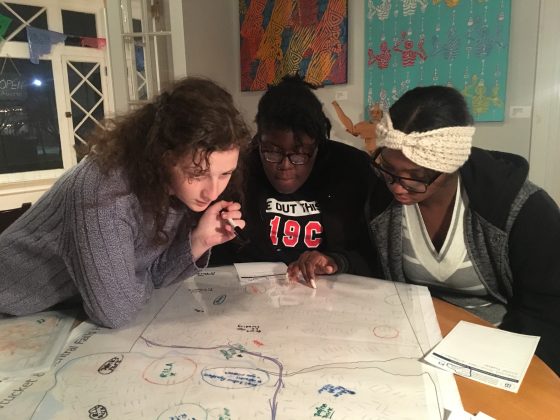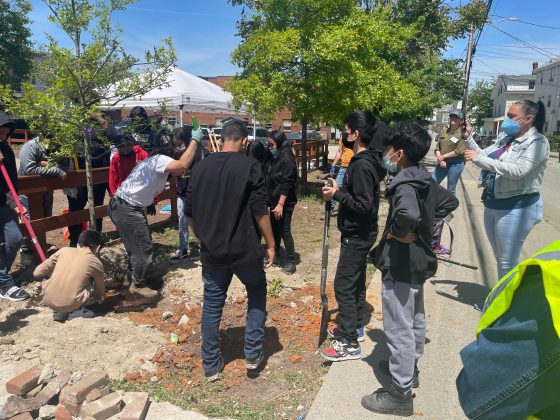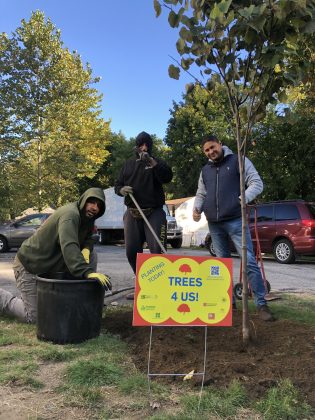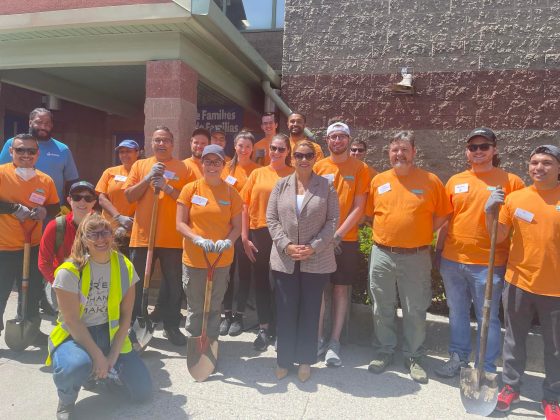resilience through tree planting in Rhode Island

Trees are essential components of healthy communities. They help purify air and water, provide shade, and serve as critical resilience infrastructure.
In the former mill towns of Pawtucket and Central Falls, Rhode Island, historic redlining policies have led to dramatic differences in tree canopy cover – the proportion of ground covered by a layer of leaves, branches, and stems of trees when viewed from above – across neighborhoods. With just 2% tree coverage on some blocks in Pawtucket’s Woodlawn neighborhood, residents experience extreme heat very acutely, particularly in their homes, during commutes to work and school, and while spending time outdoors. Buildings and pavement radiate heat all day, and as a result of the urban heat island effect, continue to emit heat during the evenings. As temperatures rise, extreme heat will increase disproportionately in these neighborhoods as compared to their greener, wealthier neighbors.
Climate safe neighborhoods
In 2018, Groundwork Rhode Island, serving Providence, Pawtucket, and Central Falls, joined the pilot cohort of the Climate Safe Neighborhoods (CSN) partnership, a program designed to explore the relationship between historical race-based housing segregation and the current and predicted impacts of climate change. Entering the program, Groundwork RI’s goal was to examine and address the root causes of extreme heat and flooding in their communities. Through the CSN program, Groundwork RI’s Green Team ground-truthed historic redlining maps of the city, comparing their own everyday lived experience with CSN maps depicting past zoning policies, surface temperature, and impervious surface coverage. They found a strong correlation between redlined areas and the risk of heat and flooding impacts today.

The Green Team also organized an outreach campaign through door-knocking and hosting community discussions to hear directly from residents living in formerly redlined districts in Pawtucket and Central Falls about how climate change impacts their lives. Residents shared that in the summer months, their routes to school and work became unbearable due to lack of shade. When it rained, stormwater collected in their yards and sidewalks and flooded basements, damaging drywall and causing mold. In addition to the nuisance of floodwater and heat, people were deeply concerned about the health impacts – especially for children.
Immediate Solutions & Systems Change: Parallel Action
Armed with knowledge from canvassing, mapping tools, and data collection, Groundwork RI set out to provide effective, short-term solutions to alleviate residents’ current challenges. Focusing on the areas with the most flooding and extreme heat risks, Green Team youth conducted audits of residents’ homes to see what interventions were possible to address residents’ interests and concerns. They then carried out a demonstration green infrastructure project in which they built and installed rain barrels and raised garden beds in people’s homes. To address extreme heat, Groundwork RI began planting trees in the community with support from the Arbor Day Foundation and others, while also investigating the Cities’ free tree planting programs to determine how effective they were in getting trees into neighborhoods with the least tree coverage.

While focusing on short-term action with immediate impact, Groundwork RI also recognized that the problem wasn’t just about existing trees – it was how trees were allocated in the first place. At the time, the City of Pawtucket planted about 50 trees each year on a first-come first-serve basis. The system for determining where those trees went was far from perfect. Applications were posted in English on the City’s website, it was unclear when new trees would become available, and, once the trees did become available, all of them were claimed within days by those already well connected to the City. In communities where trees were most needed, English is less often the language spoken at home, the Internet connection is less reliable, and awareness about the tree program is limited. These factors meant that the individuals and communities who really needed trees had the most trouble accessing them, creating a steep inequity in tree distribution.
Groundwork RI knew that three issues needed to be addressed to truly effect systems-level change. The first-come first-serve model needed to be replaced by one that was equity-based and that prioritized planting trees in areas that would provide the most benefit; the applications had to be available in additional formats, rather than just online; and the opportunity to apply to receive municipal trees had to be extended to those who are not English-proficient.
Using the data collected from their grassroots neighborhood outreach, Groundwork RI advocated for a shift away from the current inequitable tree distribution model at the city level. The team used residents’ stories to illustrate how the impacts of low tree canopy coverage are felt unequally across neighborhoods, with race and former redlining as causal factors. They worked to make residents’ concerns known to City leadership in an effort to address the root causes of climate inequity.
Expanding the Equity Coalition
In theory, framing equity-based tree planting through an environmental justice lens, as a tool to address the disproportionate impacts of extreme heat and flooding, was great. But, without significant resources, it was only an idea, not reality. Even with evidence from the community and the facts on the ground, Groundwork RI alone didn’t have the power or resources to shift the narrative, convince the City to change how trees were distributed, or greatly expand the number of trees being planted each year.
Taking advantage of growing interest in and attention being paid to the issue of tree equity on the state level, however, gave Groundwork RI the leverage it needed to make equitable tree planting a reality on the ground in both Pawtucket and Central Falls. Groundwork RI’s long-standing involvement with the Pawtucket Central Falls Health Equity Zone (PCF HEZ), which gathers public health and social service institutions together to advocate for culturally competent health services in the area, proved to be a decisive partnership that led to significant gains. In collaboration with state allies from the RI Department of Health and the RI Department of Environmental Management, and the national tree advocacy group, American Forests, Groundwork RI and the PCF HEZ reframed the lack of trees in certain areas as a public health issue, in addition to being an environmental justice issue. Fewer trees mean more extreme heat and flooding, and higher water and air pollution levels, all of which lead to negative health outcomes. Funding became available to the PCF HEZ, and as an active partner, Groundwork RI was perfectly positioned to take charge of a new equity-based tree planting program that would serve as a model of how trees can and should be planted in Pawtucket, Central Falls, and across the state.
The support and resources made available through the broader health equity-focused coalition gave Groundwork RI the leverage needed to make headway, successfully demonstrating the strong interest in tree planting across the cities of Pawtucket and Central Falls, particularly among residents who had never previously accessed the free tree programs. No longer could the City cite lack of resident interest or resident opposition to tree planting as a rationale for why trees are not planted in one area versus another.
Groundwork RI demonstrated that, given the opportunity through outreach and grassroots engagement, meaningful issue framing, and coalition building, residents across the economic, cultural, and linguistic spectrum want the benefits of trees in their community.
building trees4us

While Groundwork RI continues to be a partner in Pawtucket and Central Falls, helping to bring resources and capacity to the Cities to make their tree programs better, institutionalizing equity-based decision-making within municipal tree planting programs still has a long way to go. Moreover, even with awareness of the need for tree equity or an equity-based system for tree distribution in place, too few trees are being planted each year in Pawtucket and Central Falls to really address extreme heat and flooding due to resource constraints. Fifty new trees per year are not enough to reach the threshold necessary to mitigate heat and address flooding at the community level, roughly three to five trees per acre.
Through the support of national and local foundations and a partnership with American Forests, Groundwork RI established the Trees4Us program, a community-centered initiative to equitably expand tree cover throughout the cities of Pawtucket and Central Falls in the spring of 2021.
The goal of this program is to build the tree canopy in heat-vulnerable neighborhoods through the distribution of free trees to residents. Rather than relying on websites and internet forms, Groundwork RI led outreach efforts in Pawtucket and Central Falls that were designed to meet people where they are. Using a wide swath of data, including their CSN dashboards, GIS maps, and American Forests’ Tree Equity Score Analyzer (TESA) (one of the tree equity mapping tools used by Groundwork RI, which provides a score from 1-100, indicating whether enough trees are present in an area for everyone to benefit, based on tree canopy, surface temperature, and social determinants of health), Groundwork RI identified areas with inequitable tree canopy coverage. Through direct neighborhood outreach and community events, they recruited businesses, homeowners, and renters willing to plant trees on their property, and found volunteers eager to help with tree planting and long-term stewardship.

Since starting Trees4Us, Groundwork RI has planted and cared for 190 trees in the most climate-vulnerable areas of these cities. And now, with their model and partnerships established, Groundwork RI will be planting over 2,000 trees over the next three years in Central Falls and other northern RI cities and towns through support from the U.S. Forest Service, making tree equity an even greater reality.
The RI State Government has been helping too, by providing training to municipalities on TESA. These and related trainings are helping municipalities like Pawtucket, Central Falls, and others understand which neighborhoods are most vulnerable to climate risks and are encouraging cities and towns to shift away from a first-come first-serve tree distribution model, and instead toward one focused on the communities that most need trees.
Groundwork RI’s efforts highlight the fact that climate justice work is multidimensional and partnership-driven. The lack of trees in formerly redlined Pawtucket and Central Falls neighborhoods is not just a climate resilience problem – it’s a health equity concern, an economic issue, and a barrier to racial and social justice. Addressing the problem holistically requires the voices of all who care about and are affected by these challenges. Groundwork RI is paving (or de-paving!) the way for change by bringing these other perspectives into the climate conversation. Their work demonstrates that collaboration can profoundly impact how we approach, advocate for, and pursue resilience and adaptation work.
To learn more about Groundwork Rhode Island and its tree equity efforts, visit: Groundwork Rhode Island
